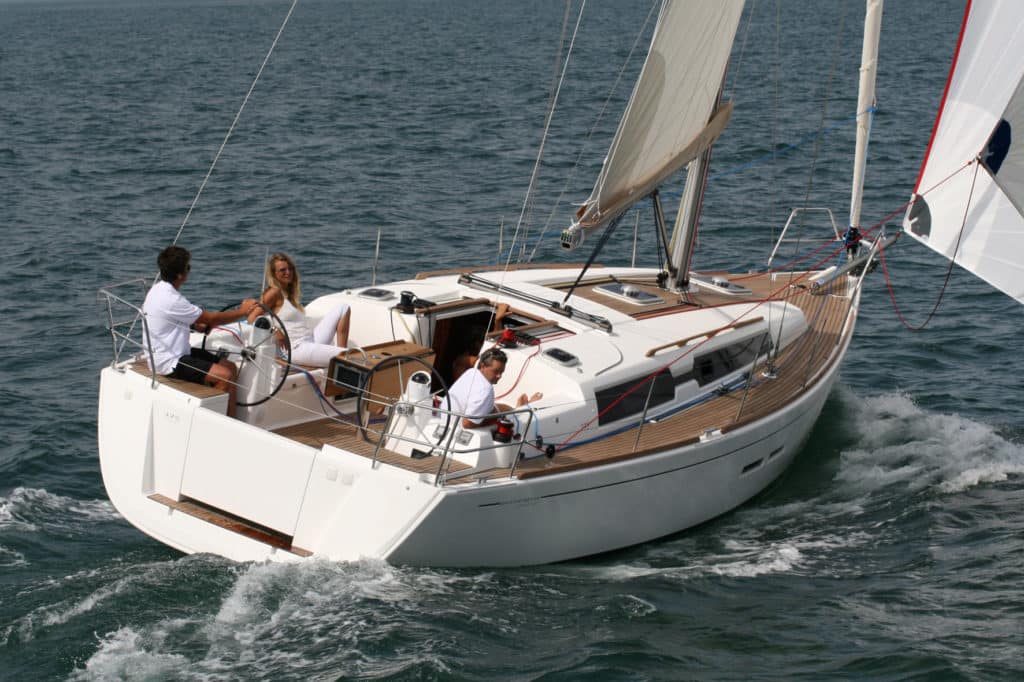
The smaller of Dufour’s new offerings is a midsize cruising boat whose sweetest charms, I discovered (as a member of the 2011 CW Boat of the Year judging panel), come to life under sail. I sailed the 375 on Chesapeake Bay last fall in a gentle southwesterly of 8 to 10 knots, where we posted boat speeds in the high 5s. One of the first things we noticed while under way was how responsive and balanced the twin helms felt, both under power and under sail. “The helm was fantastic,” said BOTY judge Beth Leonard. In fact, in the entire fleet of two dozen new boats introduced for 2011, we ranked this boat’s steering in the top five.
Drawing any boat under 40 feet, the designer must wrestle with the challenges of fitting necessary components around the relatively fixed dimensions of the human form. In the Dufour 375, especially on deck, Umberto Felci solved some of these puzzles emphatically well; belowdecks, less so. In the “Yes!” column, BOTY judge Ed Sherman loved the way the designer handled the split backstay. Two separate stays run from the masthead to the boat’s shoulders, outboard of the helm seat and just forward of the transom. This configuration leaves the walk-through transom open and avoids putting the helmsman into the neck-tweaking contortions imposed by other boats in this size range (see the complete photo gallery here).
Down below, we saw mixed results to the design puzzle. For example, the main saloon features an L-shaped dinette to port. The forward end of it uses the main bulkhead for a backrest, but clearance between the mast’s compression post and the table is a tough squeeze for any adult. And the forward cabin features an innovative fore-and-aft berth along the port side that’s much nicer than the V-berths you’ll find in other boats of this size. One of the “tests” I submitted every boat to was sitting up in bed as if to read a book—you’d be surprised how few boats will comfortably allow this simple act. The forward double berth of the 375 offers a perfect spot, letting a reader face forward and use the bulkhead as a backrest. Unfortunately, though, it only works for one person, as a shelf along the hull cuts into the berth’s outboard space.
I was pleased to see Dufour’s attention to at-sea ventilation in the cabin, with two solar vents in the overhead hatches and two clamshell scoops in the cabin top. My colleagues, though, worried that the deck-level installation of the scoops could be difficult to seal in a seaway and that the plastic material might not hold up under time and use.
Systems guru Sherman praised the access to mechanical systems throughout the 375. “As far as the overall systems access and level of installation, engine batteries, and so forth, they’re doing a great job across the board in those departments,” he said.
But Sherman was less enamored with the side-opening door to the LP storage locker, which was vented into the cockpit. That’s a case, he said, where European installation standards differ from the standards of the American Boat & Yacht Council, which require that LP lockers vent outside the boat.
Under power, the 30-horsepower diesel propelled the boat at a comfortable cruising speed of 5.6 knots and at 7 knots under full throttle. The auxiliary engine is fitted with a saildrive leg, which offers advantages in labor hours during the building. But the leg’s dissimilar metals require careful attention to anode protection against galvanic corrosion. The noise under power—89 decibels at 2,800 rpm and 98 decibels at 3,600 rpm—was right in the middle of the pack for this year’s boats under 40 feet.
Hull construction is mostly a traditional hand layup, with computer-aided design tools employed for cutting the fiberglass cloth and mat. The hull is cored from the keel up. The deck is vacuum bagged, which provides a stiff cored structure and saves hundreds of pounds. A structural liner below the cabin sole adds stiffness and bears the keel and rig loads.
“The 375 is intended for people who want to sail,” said Eric Macklin, Dufour’s U.S. importer. “A lot of boats are designed for comfort around the dock, and sailing performance can easily take a secondary priority. The first and foremost priority of the 375 is that it be fun to sail.”
Given that overview, my fellow judges and I felt that Dufour had firmly achieved the design’s primary objective.
| LOA | 36’ 8” (11.18 m.) |
| LWL | 32’ 5” (9.88 m.) |
| Beam | 12’ 8” (3.86 m.) |
| Draft (shoal) | 5’ 3” (1.60 m.) |
| (deep) | 6’ 3” (1.90 m.) |
| Sail Area (upwind) | 721 sq. ft. (967 sq. m.) |
| Ballast (shoal) | 4,298 lb. (1,950 kg.) |
| (deep) | 4,078 lb. (1,850 kg.) |
| Displacement (light ship) | 14,740 lb. (6,686 kg.) |
| Ballast/D | .29 |
| D/L | 194 |
| SA/D | 19.15 |
| Water | 100 gal. (380 l.) |
| Fuel | 53 gal. (200 l.) |
| Holding | 14 gal. (52 l.) |
| Mast Height | 51’ 10” (15.80 m.) |
| Engine | 30-hp. Volvo diesel |
| Design Group | Umberto Felci and Dufour |
| Sailaway Price | $235,000 |
Dufour Yachts
(352) 871-0362
www.dufour-yachts.com
Tim Murphy is a CW editor at large.








